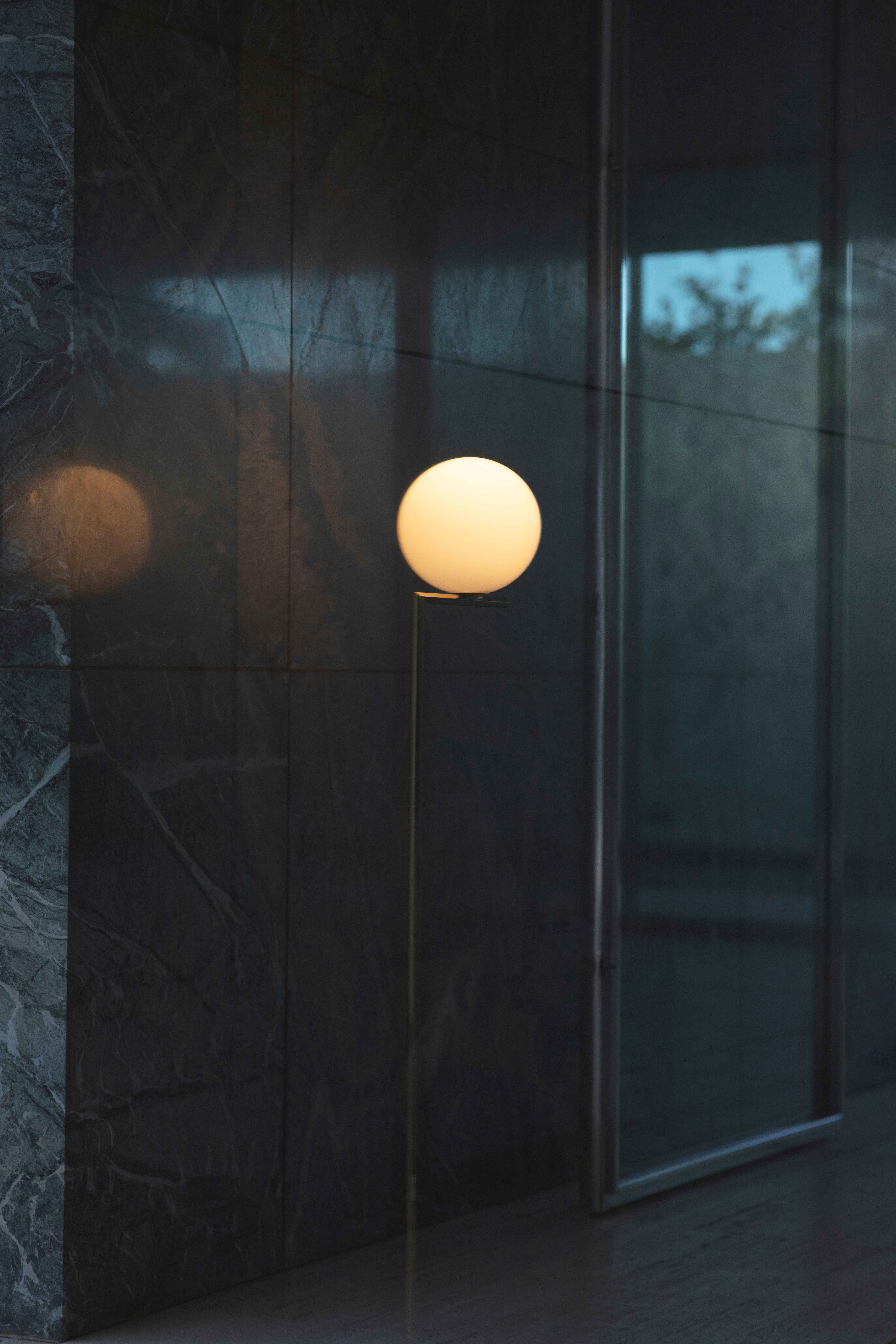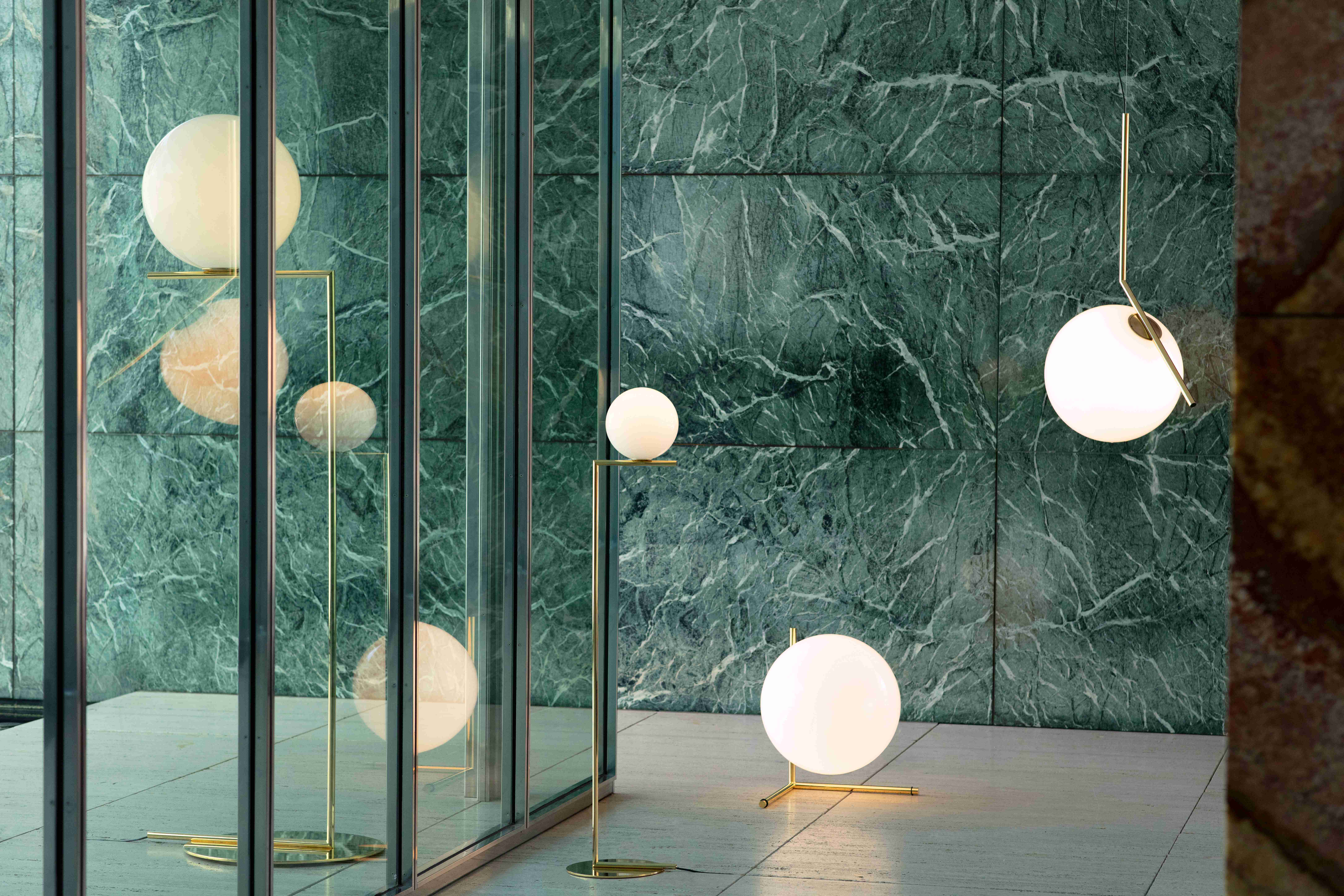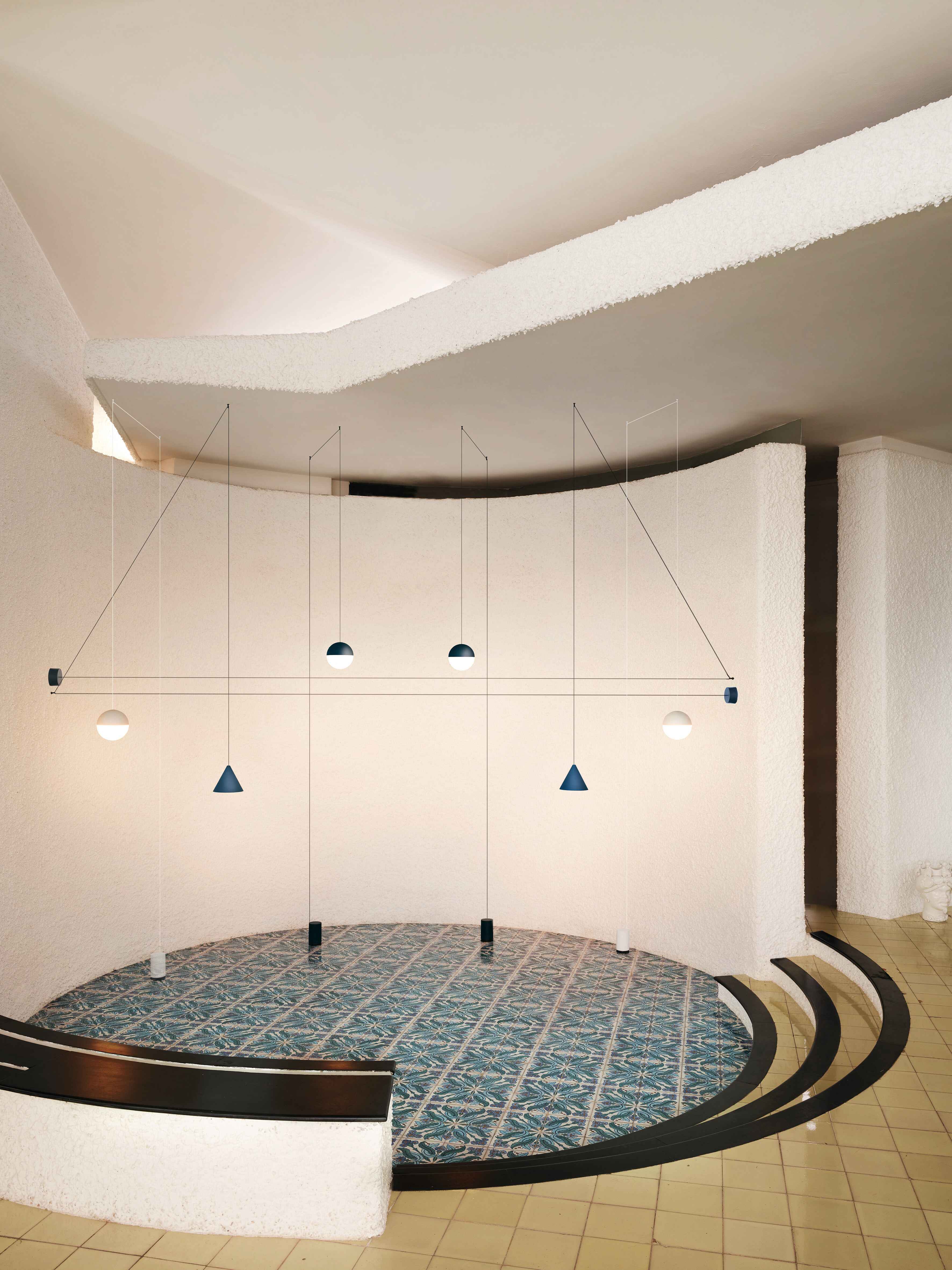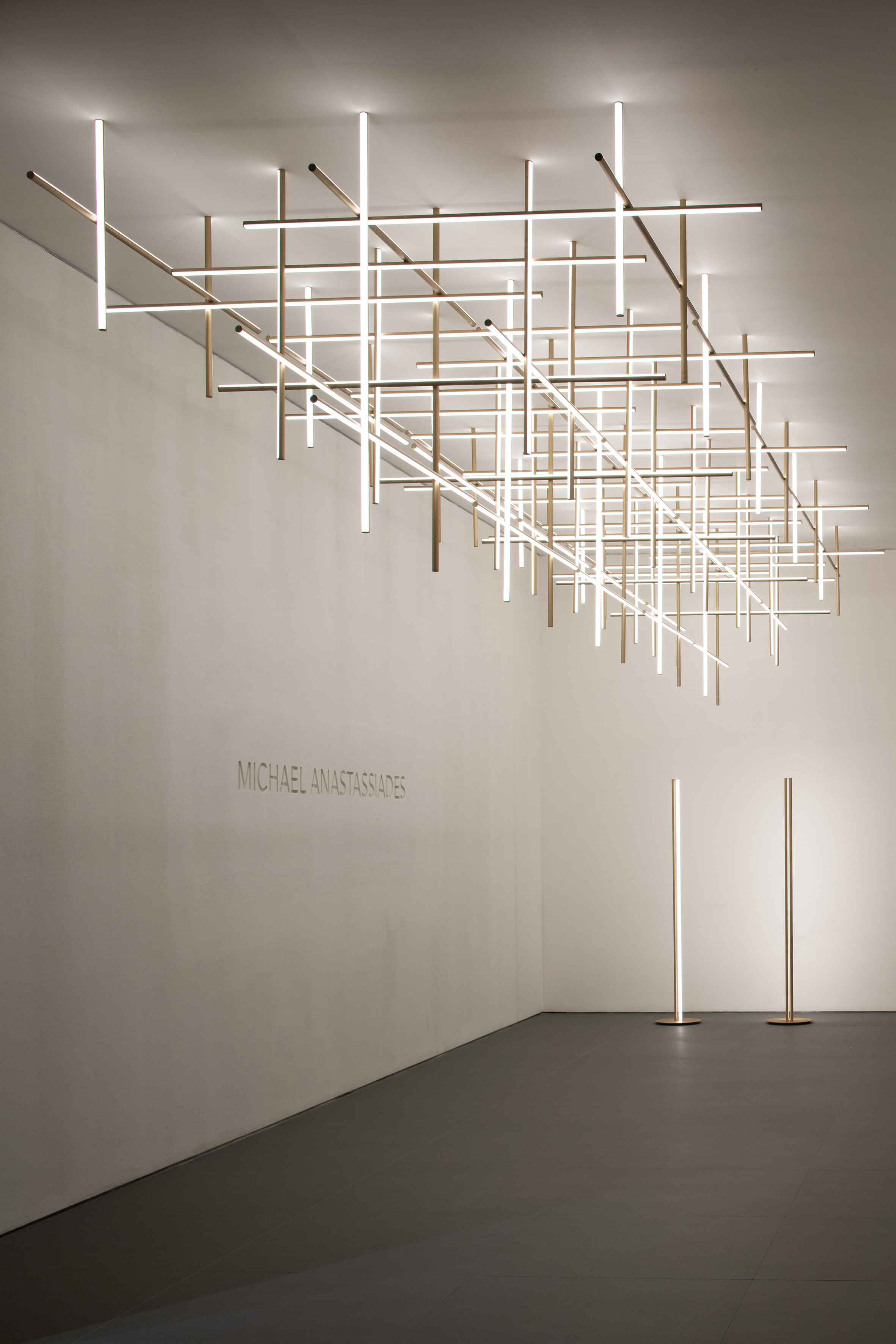When Michael Anastassiades started making money from selling his lighting designs, he decided to buy a lamp that had allured him many years before in a shop in London during the late-80s. The Memphis-style Super table lamp by Martine Bedin – a quirky, colourful contraption with wheels and a splay of light bulbs on an arc-shaped back – could not be more different from the works of the Cyprus-born, London-based designer.
 Michael Anastassiades and Flos celebrated the IC Lights collection's 10th anniversary with a numbered and signed special edition in 24-carat gold. (Photo by Daniel Riera)
Michael Anastassiades and Flos celebrated the IC Lights collection's 10th anniversary with a numbered and signed special edition in 24-carat gold. (Photo by Daniel Riera)
Anastassiades’ creations feature pure, distilled forms that one can immediately name – circle, square, line, et cetera – and are finished in natural finishes like aluminium, brass, and porcelain, void of extraneous coverings. For example, the IC lamp, produced by Italian manufacturer Flos, has a white opal glass ball poised on an angular brass frame. Also by Flos, the String light is a system that uses a very thin cord to “draw three-dimensionally into the space and at the end of the line you find a lamp,” describes Anastassiades.
But he had mentioned Bedin’s lamp to exemplify the multi-dimension of his inspirations. “Nobody could associate that side of me with [a lamp like Bedin’s] but I like a lot of things. That lamp has humour, and I’m quite certain there’s humour in my work and in the way I design,” observes Anastassiades, who was in Singapore to give a talk at Space Furniture for his work with Flos.
While his designs are simple, they are not simplistic. The IC lamp is more than just about a ball on a stick. “It’s about balance, about a kind of magic moment, about humour; these are subtleties, which is why I think that lamp has become so popular,” Anastassiates says. Indeed, the IC Lights collection, which celebrates its tenth anniversary this year, is Flos’ top-selling range.
(Related: Telling stories through interior design)
 The IC Lights collection was inspired by a video of a juggler balancing balls on their limbs. (Photo by Daniel Reira)
The IC Lights collection was inspired by a video of a juggler balancing balls on their limbs. (Photo by Daniel Reira)
Anastassiades believes the collection’s popularity is due to its accessibility. “It’s become so democratic that anyone can get their hands on it; it’s not just for the design elite,” he explains. The creative often receives emails or Instagram messages from strangers telling him how happy they are with his lamps. Some send him photographs of the luminaires in their homes. Oftentimes, these are ubiquitous, non-designer spaces that delight him more than seeing his work in branded hotels or luxury homes.
“It’s so nice and refreshing to see all these different interiors that the lamps could exist in. It’s nice to see how a lamp has touched people. It’s about how it makes them feel rather than being a status symbol,” Anastassiades remarks. The simplicity of their forms is key to this. He elaborates, “If you design from a place of familiarity, whether it’s the form, material, or so on, you’re introducing a language people already know. The user feels comfortable, so you’ve already engaged them in the conversation.”
At the same time, making something simple increases the challenge. “I need to insert many more layers in the process, so you keep discovering things as you go along [be it a detail, tactility of a material, et cetera]. Therefore, there is a higher chance you’d want to live with that object for a longer period of time,” says Anastassiades. “It’s also more difficult to make things simple; you cannot make any mistakes because they're going to be visible.”
Lamps are highly technical objects, but Anastassiades is never subservient to technology. Instead, he sees in lighting extreme possibilities to emote. “If you start with technology, you’ll never be able to push a different form of poetry. You need to see technology as a way to serve the poetry really,” he remarks.
(Related: Divine Illumination)
 Michael Anastassiades was inspired by strings of lights found in quaint village squares for the String Light collection (Photo by Omar Sartor)
Michael Anastassiades was inspired by strings of lights found in quaint village squares for the String Light collection (Photo by Omar Sartor)
Anastassiades’ creations are equal part art and science. No doubt, a diverse education contributes to that. He completed a degree in civil engineering at London’s Imperial College of Science Technology and Medicine and then a master’s degree in industrial design at London’s Royal College of Art. Four years into university, Anastassiades headed to Tokyo to intern at electronics company Toshiba. It was a decision he muses as “just an excuse to go to Japan.”
Already as a young child, Anastassiades was always hungry for creative things. Growing up in Cyprus and the time before the Internet, resources were limited. One of his main influences was Greek architect Neoptolemos Michaelides – his father’s friend who built their country house and who had studied with famous Italian architect Gio Ponti.
“I was a teenager at that time and spent a lot of time with Neoptolemos on different excursions when he went on walks. [I was also inspired by] his home with his collection of fossils, beautiful design pieces from the 60s and 70s, and even some handicrafts. That was an encyclopaedia for me,” recalls Anastassiades. Fast-forward about thirty years and that teenager is now a sought-after designer, making products for brands like Flos, B&B Italia, Vitra, Mutina, among others. His works are in the permanent collections of noted institutions like the Museum of Modern Art in New York and London’s Victoria & Albert Museum.
(Related: Meet Ken Yuktasevi, the designer behind Singapore's buzziest hotspots)
 The Coordinates collection, which comprises horizontal and vertical luminaires arranged in a grid form, is at once complex and simple.
The Coordinates collection, which comprises horizontal and vertical luminaires arranged in a grid form, is at once complex and simple.
Despite the fame, Anastassiades remains humble and ever curious. He is a delightful conservationist, giving honest answers without flair, just like his unpretentious works. Even his work is consistently pure. Even when designing jewellery for Japanese brand, Shihara, the pieces are like his lamps, but in miniature. “The scale is really different, but I see a parallel between lighting and jewellery. They both relate to the human body. I never change [how I design]. It’s a very simple language I adopt. I don't like objects to be intimidating. I like them to feel intimate,” Anastassiades says.
Over the decades, lighting has – and continues to – fascinate him. “Lights are unique products for the part that they have two lives. When it’s off, light has to work as an object, a beautiful sculpture; but when it’s on, the space it occupies become very different. Says Anastassiades with child-like conviction and awe, “Shadows, reflections, all these things – magic becomes a feature.”







 Michael Anastassiades and Flos celebrated the IC Lights collection's 10th anniversary with a numbered and signed special edition in 24-carat gold. (Photo by Daniel Riera)
Michael Anastassiades and Flos celebrated the IC Lights collection's 10th anniversary with a numbered and signed special edition in 24-carat gold. (Photo by Daniel Riera)
 The IC Lights collection was inspired by a video of a juggler balancing balls on their limbs. (Photo by Daniel Reira)
The IC Lights collection was inspired by a video of a juggler balancing balls on their limbs. (Photo by Daniel Reira)
 Michael Anastassiades was inspired by strings of lights found in quaint village squares for the String Light collection (Photo by Omar Sartor)
Michael Anastassiades was inspired by strings of lights found in quaint village squares for the String Light collection (Photo by Omar Sartor)
 The Coordinates collection, which comprises horizontal and vertical luminaires arranged in a grid form, is at once complex and simple.
The Coordinates collection, which comprises horizontal and vertical luminaires arranged in a grid form, is at once complex and simple.



-NAC Facade L2.jpg&w=500&h=550&crop-to-fit)
 Back
Back
